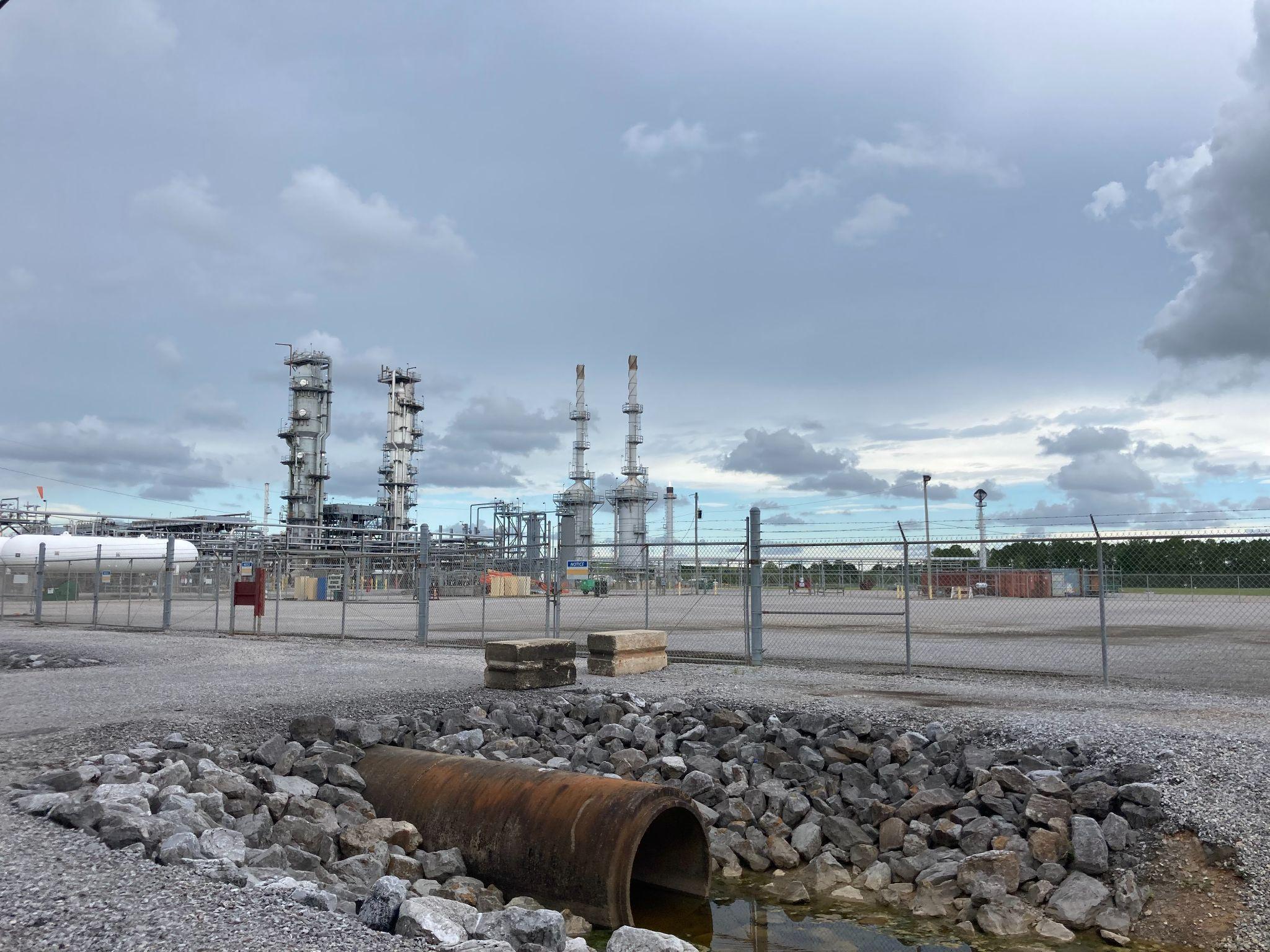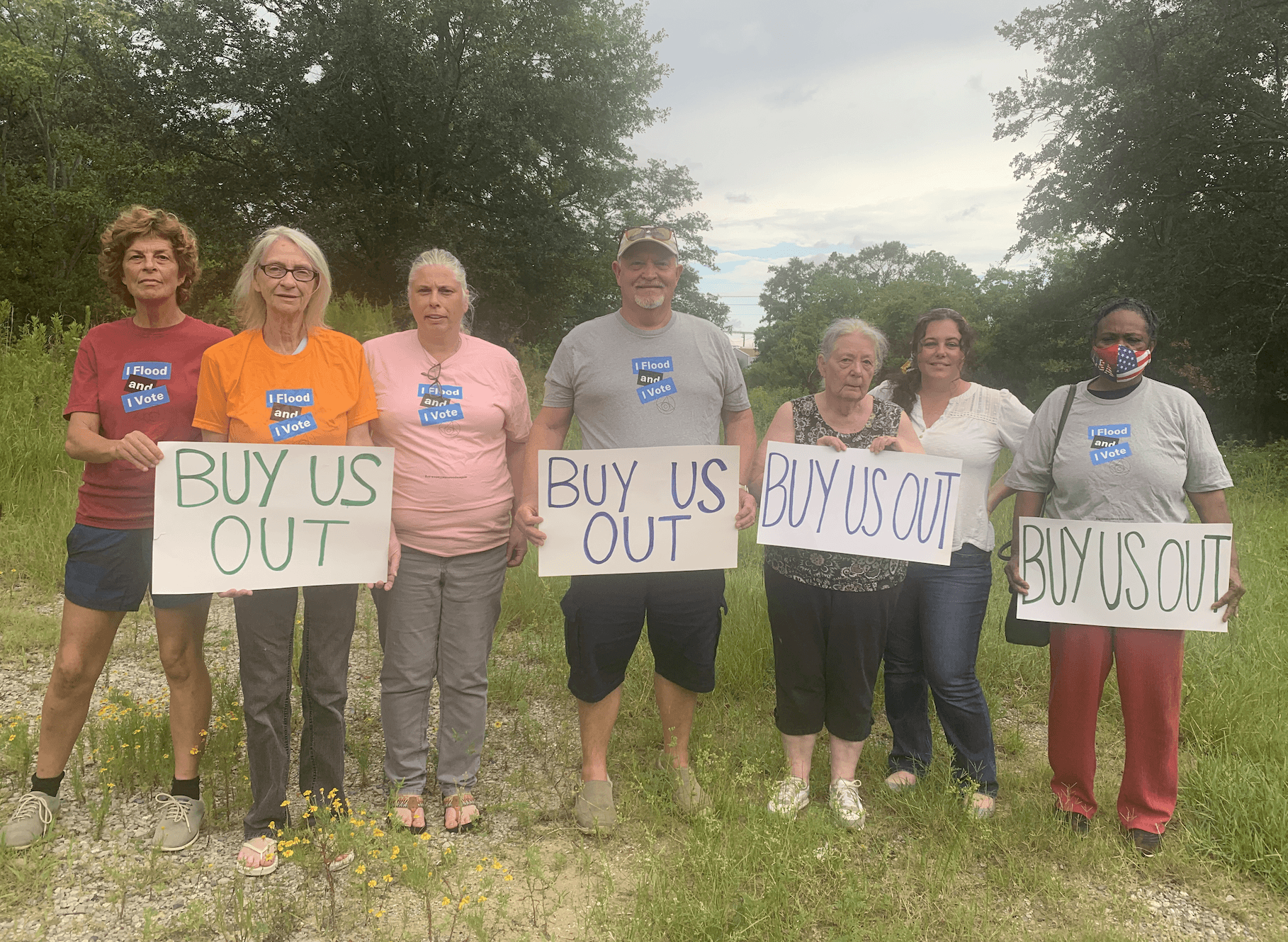
Chevron LNG processing facility in Pascagoula, MS – July 24, 2022 – Photo: Harriet Festing
The New York Times recently published a major story titled: “Living and Breathing on the Front Line of a Toxic Chemical Zone”. It addressed corporate profiteering by the petrochemical industry while communities near their plants suffered diminished health, including cancer and premature death. The Biden EPA is proposing stronger protections in such border areas, which many have called “sacrifice zones.” Impacted businesses of course claim that such measures would be unduly burdensome and hurt the economy.
The Times article focused on the Houston suburb of Deer Park, located near a huge petrochemical complex on the Houston Ship Channel, where recent studies from the EPA and city of Houston have suggested residents are at higher risk of leukemia and other cancers. As it happens, on the same day the story was published, a large fire broke out at the Shell Deer Park chemical plant sending nine workers to the hospital. A Shell spokesperson was quick to claim that air monitoring had “not detected any harmful levels of chemicals” from the fire, but Air Alliance Houston, a local non-profit organization, was skeptical.
“History has shown that these early statements are for the benefit of industry public relations and not public health,” Air Alliance’s executive director Jennifer Hadayia told Reuters. In a subsequent press release, the organization added that “History has shown that TCEQ [Texas Commission on Environmental Quality] may not be using air toxic exposure standards that are scientifically up-to-date and protective of public health.”
Oil & Gas Watch, another environmental non-profit, reported that state records indicate the Shell chemical plant had 1,946 violations over the previous decade, with 95 of them still considered active according to TCEQ. It’s no wonder the EPA opened an investigation into TCEQ in January, focused on non-compliance with the federal Clean Water and Clean Air laws. TCEQ has long been under fire from environmental watchdogs in Texas, where the Commission was once accused by Neil Carman of the Sierra Club of handing out air permits “like candy”.
More recently, the Texas Sunset Advisory Commission released a report in 2022 indicating the TCEQ was “reluctant” to regulate industry and was often found to have encouraged polluters “to self-govern and self-police.” The TCEQ is also the subject of multiple civil rights investigations by the EPA, after allegations of environmental racism in the permitting of industrial pollution.
But the problem of environmental regulatory agencies being captured by Big Polluters is a widespread national issue. According to the independent news service ProPublica, the EPA’s own New Chemicals Division is itself currently subject of an EPA Inspector General’s investigation into whistleblowers’ allegations of corrupt industry influence over chemical approval processes. That division falls under EPA’s Office of Chemical Safety and Pollution Prevention (OCSPP), which has been accused of tampering with the assessment of dozens of chemicals to make them seem safer than they actually are (subject of a 10-part series by The Intercept.)
While some might be inclined to point a finger at the Trump regime for handing over the EPA’s keys to Big Polluters from 2017-20, Kyla Bennet, Director of Science Policy with Public Employees for Environmental Responsibility says it’s not so simple. “The problems at OCSPP are not due solely to the Trump administration and its appointees,” she told The Intercept in 2021. “The issues faced by our clients occurred before Trump took office, during the Trump years, and continue now.”
On GARD in Northwest Indiana
Another front in the war over sacrifice zones is Gary, Indiana where the community-based Gary Advocates for Responsible Development (GARD) have been resisting a “waste-to-fuel” plant being promoted by regional business interests. Fulcrum Bioenergy out of California wants to build a fuel conversion plant to extract synthetic jet fuel from garbage in a process called “gasification”. The project, which would in theory convert 700,000 tons of municipal solid waste per year from the Greater Chicago region (up to 30 percent plastic) into fuel, is billed by advocates as “green infrastructure.” But the question of whether waste-to-jet fuel is a truly sustainable alternative to conventional fuel remains under debate. GARD members are concerned about the tons of pollutants that would be emitted in the process.
“We use the term greenwashing, where they make things seem like they’re green technologies when they’re really not,” GARD co-founder Lori Latham told Inside Climate News in December. Earthjustice attorney James Pew added that he views the Fulcrum project as part of a troubling national trend in which waste burning facilities are rebranding their facilities “as non-incinerators” so that they can skirt the Clean Air Act “and avoid installing pollution controls and monitoring and reporting their emissions.” Indeed, because the facility will use copious amounts of fossil fuel to affect the conversion of waste into fuel, it is unclear that there is anything green at all about the technology.

Computer generated illustration of Fulcrum’s planned facility in Gary, IN (https://www.fulcrum-bioenergy.com/centerpoint.)
GARD filed a formal appeal against the Fulcrum project’s air permit in the fall of 2022, raising the issue of unsupported emissions calculations and charging that the Indiana Department of Environmental Management (IDEM) failed to adequately consider and protect public health when approving the permit. GARD also initiated a Title VI Complaint with the EPA, alleging a pattern of discriminatory permitting decisions by IDEM’s management.
“The idea is that we should not be adding to the burden of pollution anywhere, but in this area specifically. We should be looking at businesses that are sustainable for the community and the environment, not more polluting facilities,” GARD board member Valerie Denney says, explaining that Gary is already considered an environmental justice community of concern with five Superfund sites and two hazardous waste facilities. Denney also said that Fulcrum has secured $375 million in tax-exempt revenue bonds through the Indiana Finance Authority to support the Gary project, begging the question of how such funds should be allocated.
Cherokee Concerned Citizens are fighting another plastic into jet fuel scheme
Pascagoula, Mississippi may be considered another sacrifice zone. There, Cherokee Concerned Citizens are fighting a Chevron refinery that also plans to turn discarded plastics into jet fuel. The scheme is apparently the result of an EPA initiative launched in 2022 to streamline approval of petroleum alternatives to fight the climate crisis. But the question of toxic air pollution from the process hovers over the project like that black cloud did over the Shell Deer Park chemical plant in Houston.
ProPublica reported that the allegedly “climate friendly” biofuel actually comes with a significantly increased cancer risk for those who live within three miles of the Chevron refinery in Pascagoula. The EPA claims the effort supports Congressional mandates to replace fossil fuels “with biofuels that are projected to have lower lifecycle greenhouse gas emissions.” But an EPA consent order obtained by ProPublica and The Guardian revealed that the “biofuels” Chevron intends to make from plastics in Pascagoula pose serious health risks. These include developmental problems in children, cancer, and harms to the nervous system and reproductive system. The NRDC released a report last year dismissing the entire concept of “chemical recycling” of plastics as greenwashing of incineration.
Cherokee Concerned Citizens represents Pascagoula’s Cherokee subdivision, where the Chevron refinery is just one of several petrochemical plants polluting the area. Earthustice recently filed a lawsuit on behalf of the organization against the EPA for its decision to allow the use of plastics in the process. “I applaud the legal action taken by Earthjustice to protect the people… I have written to the EPA to immediately remove approval for this practice but have not heard back,” former EPA administrator Judith Enk told Biloxi news station WLOX.

Members of Cherokee Concerned Citizens, with Harriet Festing – July 24, 2022 – Photo: Stephen F. Eisenman
Is the Earth becoming a global sacrifice zone?
The problem of marginalized communities being sacrificed for industrial profits has grown so widespread that journalist J.P. Sottile at Truthout recently went so far as to suggest that climate and energy issues are now turning the entire planet into a sacrifice zone. Sottile cites Camden, New Jersey as “the poster child for the concept of the economic sacrifice zone”.
The Center for Environmental Transformation has risen up in Camden to help lead resistance against pollution in the “post-industrial” Waterfront South neighborhood across the Delaware River from Philadelphia. (Three of the community-based organizations discussed here, GARD, CCC and the Camden group, are linked together by their membership in Anthropocene Alliance.) Camden is home to nearly 200 contaminated sites, with 27 in the Waterfront South area alone including two Superfund sites. Water quality problems are a major issue, with an outdated sewer system that overflows regularly. There’s also lead in city drinking water due to aged plumbing systems in homes.

Martin Aaron, Inc, industrial Superfund site, Camden, N.J. Photo: U.S. E.P.A.
Sottile describes Camden as “a place where disempowered people pay the price for other people’s cult-like devotion to the bottom line.” It is this cult-like allegiance to profits over people that now threatens humanity worldwide, with Sottile noting that the “sacrifice zone” concept has grown larger with the quest for “energy independence”.
“Almost daily we see, as predicted by climate and oil company scientists alike, the sacrifice zones being created by decades of flippantly burning megatons of hydrocarbons. The key difference is that our anthropomorphically altered climate exacts its toll on a global scale,” Sottile observes. “Much like the misnomer about throwing ‘away’ garbage, there is no ‘away’ for climate pollution.”
As capitalist powers like JP Morgan Chase continue financing new fossil fuel exploitation even as the global scientific community warns of an impending “climate doom loop”, it becomes increasingly clear that the issue of carbon pollution is as much about ethics and politics as it is about economics and technology. Whether humanity can evolve the collective consciousness and political will to prioritize the long-term welfare of the masses over the short-term profiteering of the few now appears to be the defining issue of the Anthropocene Age.